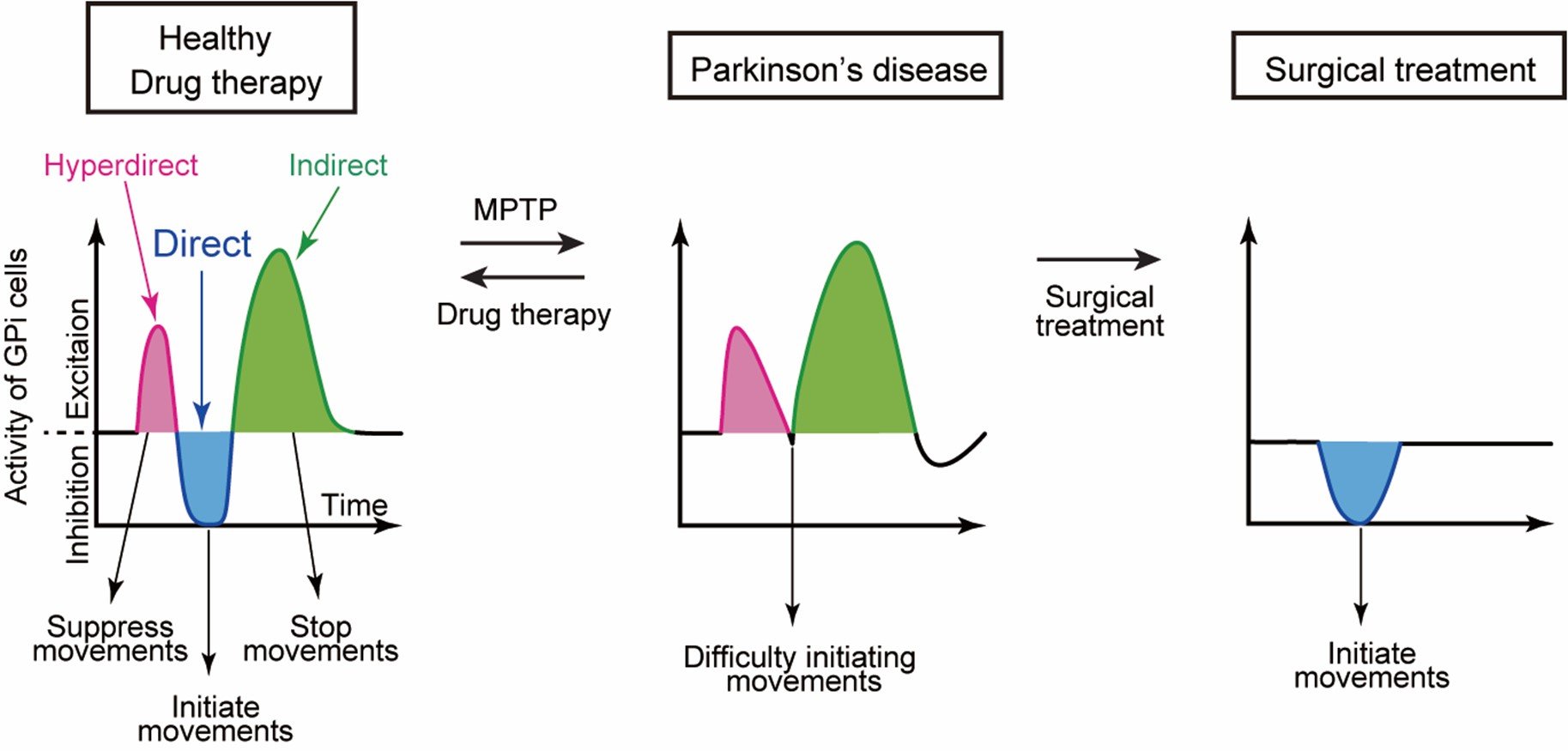Researchers at the National Institute for Physiological Sciences in Okazaki, Japan elucidated the neural mechanism of Parkinson’s disease symptoms by recording activity of neural cells in parkinsonian Japanese monkeys.
Okazaki, Japan – Parkinson’s disease is characterized by motor symptoms, such as trembling hands, muscle stiffness, and difficulty in initiation of movements, and it affects around 1% of people over the age of 60. Parkinson’s disease is caused by a lack of dopamine in the basal ganglia, which are a brain region crucial for control of voluntary movements. The researchers revealed that disturbance in information flow through the basal ganglia, particularly that through the “direct pathway”, is responsible for symptoms of Parkinson’s disease (Figure).
The research team led by Professor Atsushi Nambu made parkinsonian Japanese monkeys, and examined neural activity of in the internal segment of the globus pallidus (GPi), the output station of the basal ganglia. Electrical stimulation applied to the cerebral cortex, which induces neural activity in the basal ganglia and mimics information flow during voluntary movements, induces well-balanced excitation and inhibition in GPi cells of healthy monkeys (Figure, left); the inhibition is conveyed through the “direct pathway” that operates to initiate voluntary movements. However, in monkeys with Parkinson’s disease, the stimulation induced excessive excitation without inhibition (Figure, center), therefore initiation of voluntary movements was disturbed. On the other hand, little change in spontaneous activity of neural cells in the GPi was observed. In addition, they found that information flow through the “direct pathway” recovered when symptoms of the monkeys were relieved by drug therapy or surgical treatment (Figure, left and right). The results suggest that impaired information flow through the “direct pathway” through the basal ganglia is responsible for Parkinson’s disease symptoms.
Professor Nambu claims, “It is commonly believed that abnormal spontaneous firing rates and patterns of GPi cells cause parkinsonian symptoms. This study has provided a new perspective. Restoration of disturbed information flow through the direct pathway is the key to treat Parkinson’s disease.”
The article, “Altered dynamic information flow through the cortico-basal ganglia pathways mediates Parkinson’s disease symptoms” was published in Cerebral Cortex at DOI [https://doi.org/10.1093/cercor/bhab164].
Keywords: monkey, pathophysiology, extracellular neuronal recording, dopamine replacement therapy, subthalamic blockade

Figure. Activity of GPi cells in response to electrical stimulation of the cerebral cortex. In healthy condition (left), well-balanced early excitation, inhibition, and late excitation are observed. However, in Parkinson’s disease (center), inhibition that through the “direct pathway” is lost. Drug therapy (left) and surgical treatment (right) relived Parkinson’s disease symptoms and recovered inhibition. The results suggest that disturbance of information flow through the direct pathway, which operates to initiate movements, causes difficulty in initiating movements in Parkinson’s disease, and restoration of the information flow through the direct pathway is the key to treat Parkinson’s disease.
 Figure. Activity of GPi cells in response to electrical stimulation of the cerebral cortex. In healthy condition (left), well-balanced early excitation, inhibition, and late excitation are observed. However, in Parkinson’s disease (center), inhibition that through the “direct pathway” is lost. Drug therapy (left) and surgical treatment (right) relived Parkinson’s disease symptoms and recovered inhibition. The results suggest that disturbance of information flow through the direct pathway, which operates to initiate movements, causes difficulty in initiating movements in Parkinson’s disease, and restoration of the information flow through the direct pathway is the key to treat Parkinson’s disease.
Figure. Activity of GPi cells in response to electrical stimulation of the cerebral cortex. In healthy condition (left), well-balanced early excitation, inhibition, and late excitation are observed. However, in Parkinson’s disease (center), inhibition that through the “direct pathway” is lost. Drug therapy (left) and surgical treatment (right) relived Parkinson’s disease symptoms and recovered inhibition. The results suggest that disturbance of information flow through the direct pathway, which operates to initiate movements, causes difficulty in initiating movements in Parkinson’s disease, and restoration of the information flow through the direct pathway is the key to treat Parkinson’s disease.
